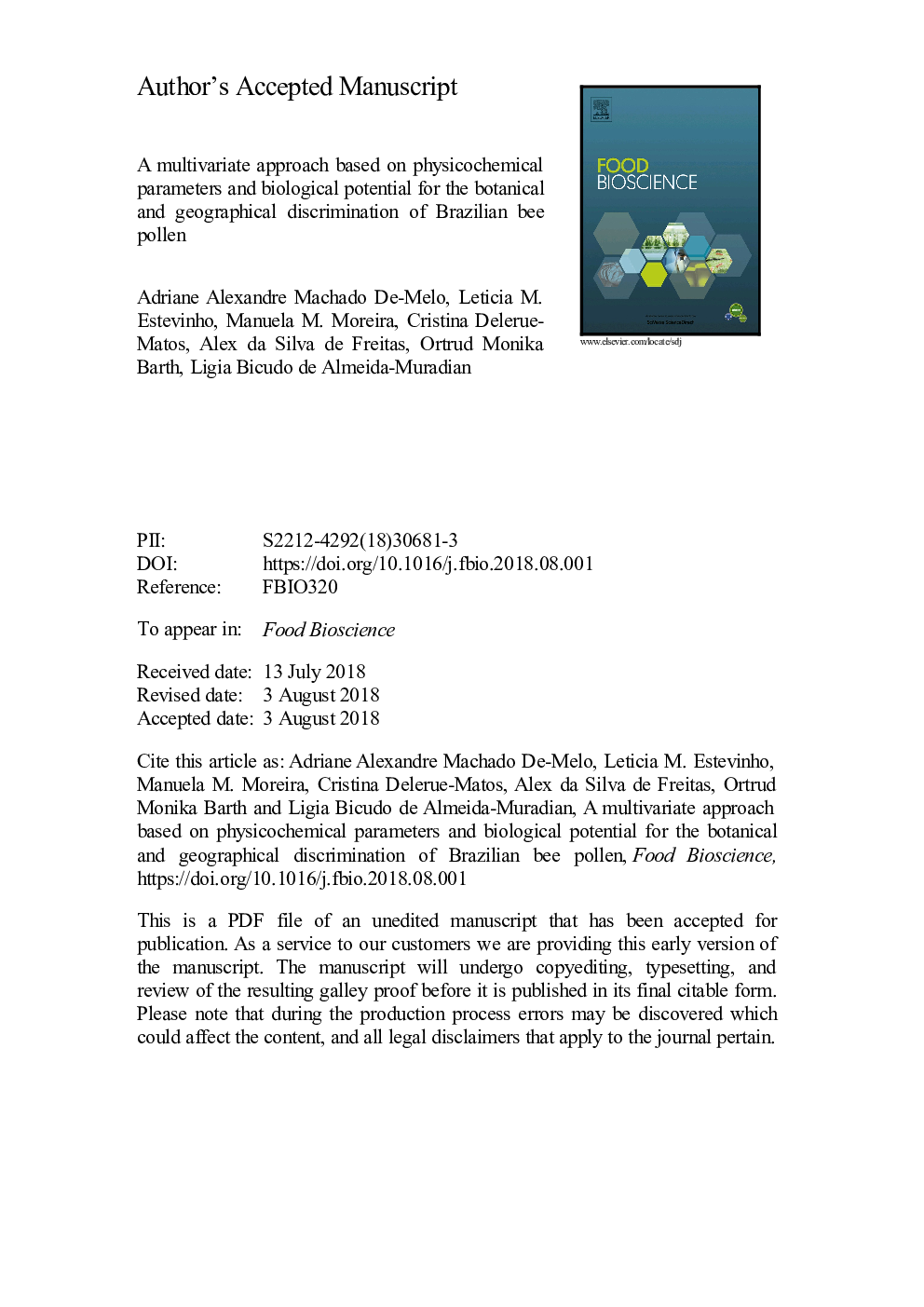| کد مقاله | کد نشریه | سال انتشار | مقاله انگلیسی | نسخه تمام متن |
|---|---|---|---|---|
| 10999808 | 1416480 | 2018 | 51 صفحه PDF | دانلود رایگان |
عنوان انگلیسی مقاله ISI
A multivariate approach based on physicochemical parameters and biological potential for the botanical and geographical discrimination of Brazilian bee pollen
ترجمه فارسی عنوان
یک رویکرد چند متغیره بر اساس پارامترهای فیزیکوشیمیایی و پتانسیل بیولوژیکی برای تبعیض گیاهی و جغرافیایی گرده زنبور عسل برزیل
دانلود مقاله + سفارش ترجمه
دانلود مقاله ISI انگلیسی
رایگان برای ایرانیان
کلمات کلیدی
محصولات زنبور عسل، خواص شیمیایی، رنگ، مشخصات فنل، مواد معدنی، شیمیدرمانی
موضوعات مرتبط
مهندسی و علوم پایه
مهندسی شیمی
بیو مهندسی (مهندسی زیستی)
چکیده انگلیسی
Fifty six Brazilian bee pollen samples were characterised, and their botanical and geographical origins were studied. The samples were also classified based on physicochemical and biological properties. The characterisation was done using Soxhlet extraction and micro-Kjeldahl methods, ashing at 550â¯Â°C, transmittance, microscopy, spectrophotometry, inductively coupled plasma optical emission spectrometry and high-performance liquid chromatography. As expected, the values of proteins (7.9-32.2â¯g/100â¯g), lipids (3.2-13.5â¯g/100â¯g), ash (1.9-3.6â¯g/100â¯g), carbohydrates (54.9-82.8â¯g/100â¯g), K (3.4-9.8â¯g/kg), Ca (0.9-4.1â¯g/kg), Mg (0.6-2.4â¯g/kg), Fe (46-1180â¯mg/kg), Na (20-374â¯mg/kg), Mn (25-215â¯mg/kg), Zn (30-101â¯mg/kg), Cu (7.4-19.7â¯mg/kg), total phenolics (6.5-29.2â¯mg GAE/g) and flavonoids (0.3-17.5â¯mg QE/g) as well as the phenolic profiles varied among the samples. In general, the products had high antioxidant capacity (ORAC: 133-563 μmol TE/g; DPPH: 9.4-155â¯Î¼molâ¯TE/g) and the antimicrobial capacity varied according to the sample and microorganism tested. The instrumental colour parameters could be used as indicators of some minerals. Based on multivariate approaches, bee pollen from Southern Brazil seemed to have a higher biological potential, whereas products from the Northeast region had higher calcium and magnesium levels. Similarities were identified in bee pollen containing C. nucifera or Brassica, and monofloral bee pollen seemed to have higher mineral content than heterofloral bee pollen.
ناشر
Database: Elsevier - ScienceDirect (ساینس دایرکت)
Journal: Food Bioscience - Volume 25, October 2018, Pages 91-110
Journal: Food Bioscience - Volume 25, October 2018, Pages 91-110
نویسندگان
Adriane Alexandre Machado De-Melo, Leticia M. Estevinho, Manuela M. Moreira, Cristina Delerue-Matos, Alex da Silva de Freitas, Ortrud Monika Barth, Ligia Bicudo de Almeida-Muradian,
